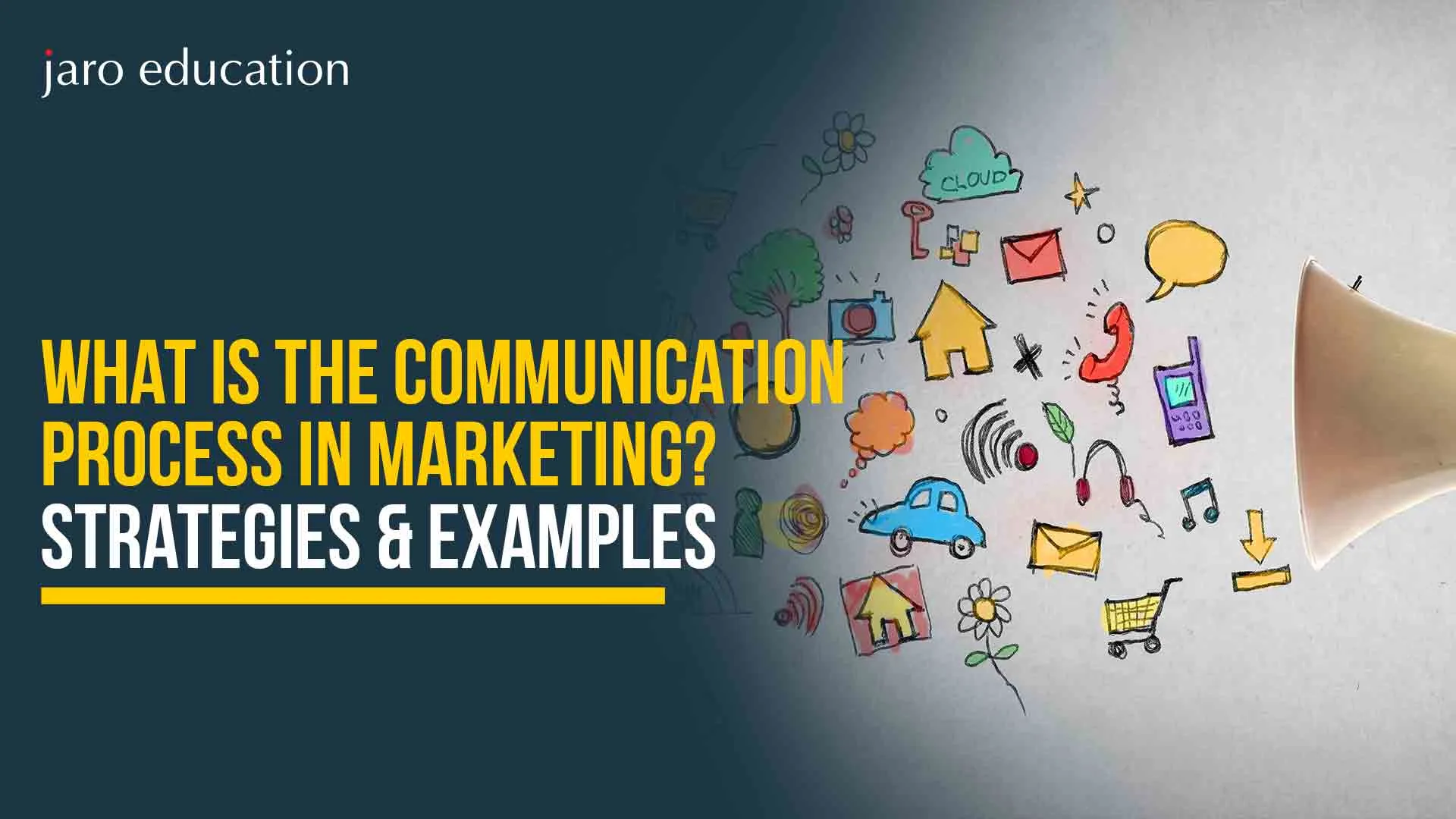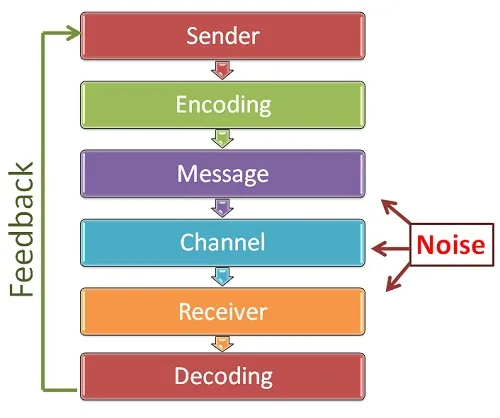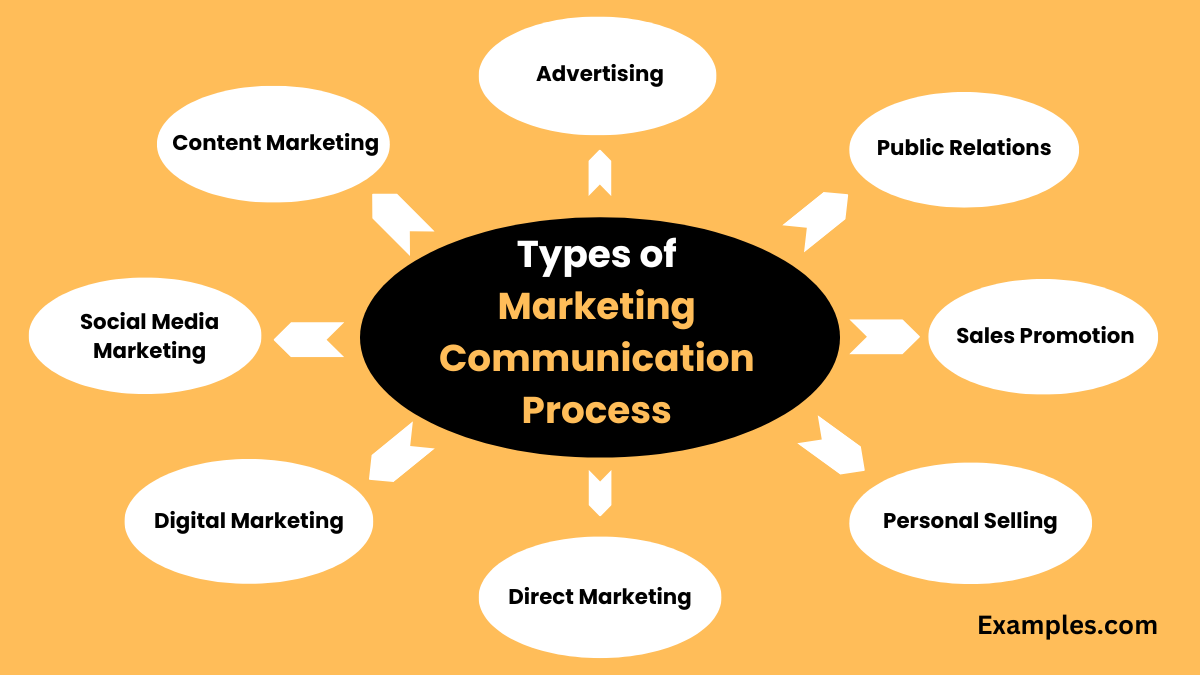What is the Communication Process in Marketing? Strategies & Examples
Table of Contents

The communication process in marketing is an effective way for companies to convey their messages about their brand, products, and services to their target audiences. The process involves various channels and strategies to deliver those messages, aiming to build brand awareness, encourage purchasing decisions, and strengthen customer relationships. Effective marketing communication strategies, like advertising and public relations, aim to influence the target audience to take a desired action, such as a purchase. This blog discusses the communication process in marketing, including the types, strategies and examples. So, let’s get started!
What is Marketing Communication?
Marketing communication, often referred to as MarCom, is the process of creating and delivering messages to communicate with customers, prospects, and other target audiences. This process involves several tools and channels to convey information about a product, service, or brand. Marketing communication aims to inform and convince the target audience about the value proposition of a company’s offerings, taking desired actions, like making a purchase.
Objectives of Marketing Communication (MarCom)
The following are the objectives of MarCom:
- Building Brand Awareness and Preference: Marketing Communication helps create a positive insight of the brand in the consumers’ minds, leading to improved preference for products or services.
- Generating Demand: MarCom drives customer interest and inspires them to take action, such as purchasing a product or visiting a website.
- Influencing Behaviour: MarCom aims to encourage consumers to adopt a specific behaviour, like trying a new product or accepting a particular lifestyle.
- Building Relationships: MarCom helps connect with customers, creating a sense of community and loyalty.
Communication Process in Marketing

*theintactone.com
The communication process in marketing involves a sender (the brand or company) creating a message and conveying it through a chosen channel to a receiver (the customer), who then understands and ideally provides feedback. The key steps of the communication process include recognising the target audience, determining communication objectives, creating messages, selecting communication channels, and measuring feedback.
Here are the basic communication process steps:
- Sender (Source): Also referred to as a source, a sender is the brand or company that initiates the communication process. They are responsible for encoding the message, choosing the communication channel, and sending it to the receiver.
- Encoding: The sender uses encoding to transform an idea or message into an understandable form for the target audience.
- Message: The next step includes the content and format of the message, which can be an ad, a blog post, or a social media update. The message should be effective and clear enough to reach the communication objectives.
- Channel: In the communication process, the channel or system is the medium through which the message is conveyed (for example, TV, email or social media).
- Receiver: The receiver is the individual or group of individuals who are intended to receive and understand the message. And, this often refers to the customer.
- Decoding: After receiving the message, the receiver decodes it, which involves interpreting the message and assigning meaning to it based on their understanding and experiences. This decoding step is crucial for the effective communication process.
- Feedback: The receiver’s response to the message is called feedback, which is essential for effective communication. It is the information the receiver sends back to the sender after decoding and interpreting the message.
Types of Marketing Communication

*examples.com
There are several types of marketing communications through which a company conveys its message to the public and potential customers. Some of the common types of marketing communication include:
- Advertising: Advertising helps agencies create ads to connect with a wide audience and encourage them to purchase products or services. This type of communication process is expensive yet effective in building brand awareness, influencing purchasing decisions, and boosting sales.
- Public Relations (PR): This is one of the most effective types of communication that utilises third-party sources to convey information about a certain brand or product, which enhances its credibility and builds trust with the public. This process can be highly effective because it directly impacts the organisation, leading to a more objective and more believable message.
- Digital Marketing: Digital marketing is an essential communication process in marketing that helps businesses connect with potential customers, build relationships, and drive engagement through several online channels. Unlike traditional marketing, which is often one-way, digital marketing promotes a 2-way communication process, enabling customers to foster interaction and participation in their brand’s story.
- Content Marketing: Content marketing is a useful communication process in marketing that focuses on developing and distributing valuable, relevant, and reliable content to attract and engage a specific audience. Instead of aggressively promoting products, content marketing builds trust, educates, and guides potential customers through educational and engaging content.
- Social Media Marketing: Social Media Marketing is an essential communication process in marketing that provides a platform for businesses to interact with their target audience, build relationships, and promote their products or services.
How to Create a Marketing Communication Strategy?

*theintactone.com
The steps to create a marketing communication strategy are as follows:
- Identify Your Target Audience: Identifying the target audience is an essential first step for developing a marketing communication strategy. It includes understanding the specific demographics, psychographics, and behaviours of the group to respond to your message. Additionally, defining your communication goals, segmenting your stakeholders, and selecting your target audience based on various factors are also involved in this strategy.
- Define Your Unique Value Proposition: To create a marketing communication strategy, defining your Unique Value Proposition (UVP) is a crucial step. A UVP in marketing is a concise statement that explains why a customer should choose one product or service over others. It should connect the benefits and how it solves customer problems, differentiating it from competitors.
- Focus on Solving Customers’ Problems: A marketing communication strategy that focuses on solving customers’ problems includes identifying customer requirements, creating targeted messages, and using suitable channels to communicate effectively about addressing your product or service needs. The aim of this strategy is to build strong customer relationships by representing the value of your offering in solving specific problems.
- Choose Channels to Deliver Your Message: Choosing the right marketing communication channels is important for delivering your message effectively to potential customers. This strategy includes considering the audience’s preferences, the message, and the overall marketing goals.
- Measure the End Result: Measuring the end result of a marketing communication strategy is essential for assessing its effectiveness and making data-driven decisions. This includes setting clear goals, defining key performance indicators (KPIs), and tracking results over time. By evaluating data, you can track what is working, what is not, and how to improve your strategy for better results.
Importance of Marketing Communication
Marketing communication is an important process for businesses, as it enables them to connect with customers, build brand awareness, and promote sales. This communication process is useful to convey a company’s message and value proposition to its target audience through various channels, establishing and maintaining strong relationships with customers and other stakeholders. So, here are some reasons why marketing communication is important.
- Building Brand Awareness and Recognition: Marketing communication helps make a brand recognisable and memorable to its target audience. By consistently conveying a brand’s message across various channels, it can enhance brand awareness and establish a strong brand image.
- Enhancing Customer Relationships: Marketing communication helps engage with customers through various channels, like social media, email, and content marketing. Also, it helps build trust by consistently connecting with customers and providing valuable information and experiences.
- Driving Sales and Profitability: Effective marketing communication can influence consumer behaviour and persuade them to purchase products or services. Communicating the value proposition of a product or service helps increase sales and profitability.
- Reaching New Markets and Expanding Reach: Marketing communication helps businesses to target different audiences with personalised strategies, expanding their reach and accessing new markets. It can also help understand and respond to customer requirements.
- Building a Strong Brand Identity: Marketing communication plays an important role in creating a strong and unique brand identity, making a company stand apart from its competitors. It helps communicate the brand’s values, personality, and what makes it stand apart from other brands in the market.
- Influencing Consumer Behaviour and Attitudes: Marketing communication can be used to inspire consumer behaviour and change their minds towards a brand or product. Strategically conveying a brand’s message can help persuade customers to make specific purchasing decisions.
- Facilitating 2-way Communication Process and Engagement: Marketing communication is now more about a 2-way communication process and engagement, where businesses use digital channels to communicate with their target audience. This allows the creation of more personalised and relevant messages, leading to stronger customer relationships and brand loyalty.
Examples of Marketing Communication
Here are some examples of marketing communication:
- A TV ad displaying a new car’s features and benefits: Here, the sender is the car manufacturer, the message is the ad, the channel is TV, and the receiver is potential customers.
- A social media campaign promoting a new product launch: Here, the sender is the company, the message is the campaign content, the channel is social media, and the receiver is followers and potential customers.
- A press release announcing a company’s partnership with a charitable organisation: Here, the sender is the company, the message is the press release, the channel is public relations (PR), and the receiver is media outlets and the public.
The Bottom Line
Marketing communication (MarCom) includes all the messages and media a company uses to connect with its target audience, including advertising, direct marketing, branding, social media marketing, and online presence. It is a crucial part of a company’s marketing efforts and aims to inspire the target audience to take a desired action, such as making a purchase.
Now that you know the communication process in marketing, we hope our guide will help you develop an effective strategy for your company.
If you need expert advice on the communication process in marketing, then you can connect Jaro Education for further guidance.
Frequently Asked Questions
What is the purpose of marketing communication?
The main purpose of marketing communication is to effectively inform, influence, and remind a target audience about a product or service, making a purchase decision and supporting the company’s overall marketing objectives.
What are the five types of marketing communication?
The five main types of marketing communication are:
- Advertising
- Sales Promotion
- Public Relations
- Direct Marketing
- Personal selling.
These are the primary ways that help companies communicate with their target audiences to build brand awareness, create interest, and drive sales.
How does the communication process work?
The communication process in marketing involves a sender encoding a message, selecting a channel, sending it to a receiver, who decodes the message, and then providing feedback. The key elements include a sender, encoding, a message, a channel, a receiver, decoding and feedback.
What is the first process involved in marketing communication?
The first process involved in marketing communication is defining clear objectives and goals. This includes determining what you want to achieve with your marketing efforts, such as increasing brand awareness, driving sales, or building customer loyalty. These goals should be SMART, an acronym for Specific, Measurable, Achievable, Relevant, and Time-bound, providing a framework to set clear and actionable objectives.
What is the budget for marketing communication?
The budget for marketing communication can be a percentage of revenue, ranging from 2-5% for B2B companies and 5-10% for B2C companies. It can also be a percentage of the overall budget, with some companies allocating a significant portion to marketing.
What is an example of a 2-way communication process?
A 2-way communication process explains that both parties involved in a communication method actively convey and receive information, creating a to-and-fro discussion. For example, it is a face-to-face conversation where each person listens to and responds to the other.
Why is feedback a crucial process in communication?
Feedback is a crucial process in marketing communication, as it ensures understanding and allows you to improve effectiveness by modifying the message. It completes the communication process by providing the senders with the perception whether their message was understood as intended and allowing receivers to clarify any misunderstandings.

















